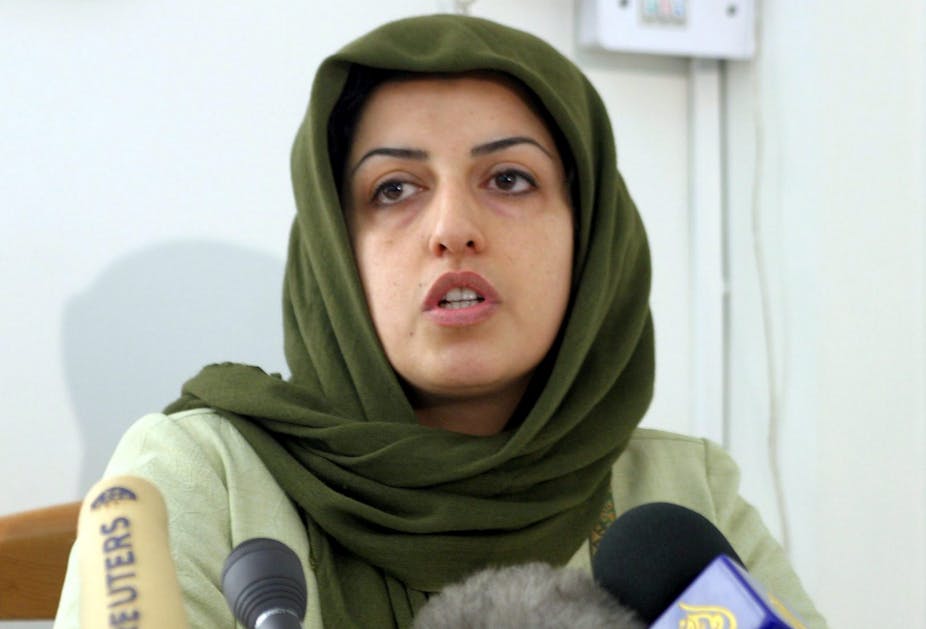Narges Mohammadi, the recipient of the 2023 Nobel peace prize for her long fight against the oppression of women in Iran, is reported to have started a hunger strike. Her family told CNN this week that she began refusing food on Monday in protest over what she said was the jail’s refusal to provide her with medical treatment.
Mohammadi is serving multiple sentences in Iran’s infamous Evin prison on charges that include spreading propaganda against the state. Her rights campaigns were characterised by the Nobel prize committee as a “brave struggle [that] has come with tremendous personal costs”.
While in jail, Mohammadi has made several statements in support of the “women, life, freedom” protest movement that erupted in 2022 following the death in the custody of Iran’s morality police of 22-year-old Kurdish Iranian woman Jina Mahsa Amini. Ahmini was detained for allegedly wearing the compulsory hijab in an improper manner.
The protests quickly spread across Iran and have become one of the most serious challenges to the country’s theocratic regime in years. The protests have been met with a brutal crackdown by security services. Hundreds were killed and thousands have been arrested for taking part in the street protests. According to data gathered by non-profit organisation Iran Human Rights, five protesters and 13 women have been executed in 2023.
Read more: Violent crackdown against Iraq protests exposes fallacy of the country's democracy
On September 25, a new “hijab and chastity” law was passed in Iran, which equates not wearing a hijab – either in public or virtually – as “nudity”. In April, authorities began installing cameras in public places in Iran’s cities. The hated morality police also resumed its patrols. Both of these factors will make it easier to identify and detain women who disobey the new law.
Women, life, freedom
The slogan “women, life, freedom” (in Persian Jin Jiyan Azadi) originates with the Kurdish women’s movement in the early 2000s, fighting government oppression in Turkey and Islamic State extremism in Iraq and Syria. It has since been adopted by Iranian women protesting Amini’s death. Social media – among women in Iran and worldwide – has been buzzing with the hashtag.
The protests were sparked by the oppression of Iranian women and have been led by women, but supported by many men and have morphed into a fight for regime change. A survey of 158,000 people in Iran in December 2022 found that 80% of people reject the Islamic theocracy under which they currently live in favour of a democratic system.

It is not the first time women have played leading roles in the fight for change in Iran. Women were at the forefront of the mass protests that led to the downfall of the last shah of Iran.
Ironically, in those days, wearing a hijab was seen as a revolutionary act as it had been banned by Reza Shah Pahlavi in 1936. Despite the ban being rescinded by his son five years later, the association between Iran’s monarchy and repression of women remained and many women marching in the years leading up to the 1979 revolution donned the headscarf as a symbol of defiance.
In 1983, four years after the revolution, the Islamic authorities passed a law making the wearing of the hijab compulsory. Again, many women defied the law and were sentenced to prison, given fines or lashed.
Read more: Hijab law in Iran over the decades: the continuing battle for reform
The conservative regime of Mahmoud Ahmadinejad, who was president from 2005 and 2013, forced many rights protesters to move abroad. But those who stayed increasingly used newly developing digital tools such as social media to campaign and share stories of harassment and discrimination.
Hunger strike
Narges Mohammadi has become a key figure in the women’s rights movement in Iran. Despite having trained as an engineer, she took up journalism and wrote regular criticisms of the treatment of women, as well as the the country’s poor human rights record in general.
This brought her to the attention of the authorities during Ahmedinajad’s presidency and after his widely disputed reelection in 2009, she was among thousands arrested for taking part in the protests that followed.

In the years since, Mohammadi has been imprisoned several times, even being convicted after being unsuccessfully nominated for the Nobel peace prize in 2021. As an inmate in the notorious Evin prison in Tehran, she has led women’s resistance in support of the woman, life, freedom campaign.
According to a statement from her family released by the Free Narges Mohammadi campaign, she began her hunger strike in response to two issues: “The Islamic Republic’s policy of delaying and neglecting medical care for sick inmates, resulting in the loss of the health and lives of individuals. The policy of ‘death’ or ‘mandatory hijab’ for Iranian women.”
Her family said that an Iranian prosecutor refused to grant Mohammadi’s request to be transferred a heart and lung hospital for “urgent medical care” after refusing to wear the hijab.
Despite the global attention on the women’s struggle in Iran and Mohammadi’s Nobel prize, the brutality of Iranian authorities against women continues. A 17-year-old girl, Armita Geravand, died in October after receiving a head wound while riding Tehran’s metro without a headscarf.
Nasrin Sotoudeh, a 60-year-old rights campaigner was arrested while attending her funeral without a hijab. She too was beaten and suffered severe head injuries. Like Mohammadi, she too has been denied medical treatment.
But today’s Iranian women enjoy far stronger social support. Recent events show how they have become active agents seeking to drive change. To support these women, it is essential to stand with all of them against all pressures that they face.
In the fight against the global rise of authoritarianism, the key might lie in supporting women’s rights and grassroots feminist activism.

